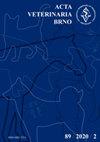Hypothermia as a potential remedy for canine and feline acute spinal cord injury: a review
IF 0.7
4区 农林科学
Q3 VETERINARY SCIENCES
引用次数: 1
Abstract
Severe spinal cord injury (SCI) resulting in permanent sensory-motor and autonomic dysfunction caudal to a damaged spinal cord (SC) segment is a catastrophic event in human as well as in veterinary medicine. The situation of paraplegic/tetraplegic people or animals is further impaired by serious complications and often displays an image of permanent suffering. Therapeutic hypothermia (TH) has shown neuroprotective capacity in numerous experimental and several clinical studies or case reports. Hence, the method draws increasing attention of neuroscientists as well as health care workers. While systemic TH is a too complex procedure for veterinary practice, local application of TH with a reduced risk of the whole body temperature fluctuations and minimal side effects can become one of the therapeutic tools considered in the treatment of acute traumatic SCIs in bigger animals, especially when surgical decompression of spinal medulla and vertebral column reconstruction is indicated. Still, additional large prospective randomized studies are essential for the standardization of therapeutic protocols and the introduction of the method into therapeutic armamentarium in canine and feline spinal traumatology. The research strategy involved a PubMed, MEDLINE (Ovid), EMBASE (Ovid), and ISI Web of Science search from January 2000 to July 2021 using the terms “canine and feline spinal cord injuryˮ, “hypothermiaˮ, and “targeted temperature managementˮ in the English language literature; also references from selected studies were scanned and relevant articles included.低温作为犬和猫急性脊髓损伤的潜在补救措施:综述
严重脊髓损伤(SCI)导致永久性的感觉运动和自主神经功能障碍,是人类和兽医学中的灾难性事件。截瘫/四肢瘫痪的人或动物的情况因严重并发症而进一步受损,并经常显示出永久痛苦的形象。治疗性低温(TH)在许多实验和一些临床研究或病例报告中显示出神经保护能力。因此,这种方法越来越受到神经科学家和卫生保健工作者的关注。对于兽医实践来说,全身TH是一个过于复杂的过程,局部应用TH可以降低全身温度波动的风险,并且副作用最小,可以成为治疗大型动物急性创伤性SCIs的治疗工具之一,特别是当需要进行脊髓减压和脊柱重建手术时。尽管如此,额外的大型前瞻性随机研究对于治疗方案的标准化和将该方法引入犬和猫脊柱创伤学的治疗设备是必不可少的。研究策略包括2000年1月至2021年7月在PubMed, MEDLINE (Ovid), EMBASE (Ovid)和ISI Web of Science检索英语文献中的术语“犬和猫脊髓损伤”,“低温症”和“靶向温度管理”;还扫描了选定研究的参考文献并纳入了相关文章。
本文章由计算机程序翻译,如有差异,请以英文原文为准。
求助全文
约1分钟内获得全文
求助全文
来源期刊

Acta Veterinaria Brno
农林科学-兽医学
CiteScore
1.00
自引率
33.30%
发文量
36
审稿时长
18-36 weeks
期刊介绍:
ACTA VETERINARIA BRNO is a scientific journal of the University of Veterinary and Pharmaceutical Sciences in Brno, Czech Republic.
The scientific journal Acta Veterinaria Brno is dedicated to the publication of original research findings and clinical observations in veterinary and biomedical sciences. Original scientific research articles reporting new and substantial contribution to veterinary science and original methods that have not been submitted for publication elsewhere are considered for publication. A written statement to this effect should accompany the manuscript, along with approval for publication by the author´s head of department. The authors bear full responsibility for the contents of their contribution. Book reviews are published, too.
 求助内容:
求助内容: 应助结果提醒方式:
应助结果提醒方式:


